Ficinia
Ficinia Schrad.
Family: Cyperaceae
Common names: sedges (Eng.); biesies (Afr.); Ficinia radiata : star grass (Eng.) stergras (Afr.)
Introduction
The genus Ficinia of the tribe Scirpeae is remarkable in that almost all of the ± 60 species are endemic to the Cape Floristic Region. Species range from tiny, inconspicuous individuals to the eye-catching 'yellow star' display of Ficinia radiata. Apart from F. truncata, not many species of this genus are used in horticulture; despite this, many could contribute by providing attractive foliage in an aquatic or dry setting and they are very easily propagated.

Description
Description
Species in this genus are perennial, spring-flowering, herbaceous sedges, growing in clumps or possessing rhizomes or horizontal stems that sometimes branch. The leaf blades are often poorly developed, leaf sheaths are papery with a ligule. The flower head bears bisexual flowers and is situated at the end of the stem, consisting of spikelets clustered in dense heads or panicles. Spikelets have a few to many spiral, or rows of, glumes (i.e. paired bracts at the base of the spikelet) on opposite sides of an axis.
Ficinia bears resemblance and is closely related to Isolepis, but differs in that Ficinia displays the presence of a small, lobed, cuplike disc or gynophore attached to the base of the achene (i.e. the small, dry, indehiscent fruit with a single cavity and seed) below the ovary. Species of Isolepis do not possess a gynophore. There are, however, a few species of Ficinia that do not possess the disc (F. tenuifolia, F. nodosa and F. rigida) making them difficult to tell apart from Isolepis.
It is often difficult to draw the line between the gynophore of Ficinia and the expanded foot of the nut of many species of Scirpus. Species of Ficinia that do not possess a gynophore are nevertheless 'ficinioid' in appearance. A 'ficinioid' appearance is one in which the leaf blades are erect and sometimes rigid and may be cylindrical and stem-like rather than flattened and leaf-like; the membranous leaf sheaths are often prolonged upwards into ligules and the inflorescences are often condensed and compact, inversely egg-shaped to elliptical and enveloped by a whorl of bracts formed by the dilated bases of the outer bracts. There is a longitudinally striated appearance and the bracts-and sometimes the glumes within them-often have a hard, brittle texture.
Conservation Status
Status
Although none of the species in the genus Ficinia appear on the Red List of threatened plants, the majority of species are endemic to the Cape Floristic Region, making them likely future candidates for the Red List.
There are four species in the genus that are of concern, namely Ficinia gydomontana, F. micrantha, F. pygmaea and F. quinquangularis. They are all listed as 'Least Concern' at present but are rare. These species are threatened by human-induced habitat loss and degradation, including forestry, population expansion and drought. When climate change is taken into account, one recognizes that many species of Ficinia may become threatened in future. These threats are severe since the genus consists of a majority of species endemic to the Western Cape.
Distribution and habitat
Distribution description
About 60 species exist, mainly southern African, mostly in the winter rainfall region of the Western Cape with a few in the Northern Province, Mpumalanga, Free State, Swaziland, Kwazulu-Natal, Lesotho, Northern and Eastern Cape. The remaining species extend beyond the borders of South Africa. Of these, one occurs in Namibia (Ficinia nigrescens) and approximately two extend across the East African mountains reaching Tanzania (these also occur in South Africa). Two species are from Abyssinia; one being endemic there (Ficinia clandestina) and the other also occurring in South Africa.
Only approximately five species are found outside the African continent; of these, three are from the Malagasy Republic and two have been incorrectly reported from the East Indies. One species supposedly also occurs in Australia and New Zealand and doubtful records report a species to occur in Madagascar. Plants are found in open vegetation often on sandy or rocky ground.
Ficinia is a characteristic genus of the Cape Flora i.e. fynbos, and is the largest genus of Cyperaceae that can be found outside tropical South Africa. There are at least thirty-three species in the Cape Peninsula alone.
Derivation of name and historical aspects
History
The genus Ficinia was established in 1832 by Schrader in his Analecta ad floram capensem, and was named in honour of D.H. Ficini who was the author of a Flora of Dresden. However, as far as can be ascertained, he had no connection with the Cape flora or with the Cyperaceae, so it is doubtful why the genus was named after him. The name Ficinia was not the only name for the genus. In 1871 O. Kuntze replaced the name Ficinia with Melancranis. This change was never officially accepted or applied in practice and for this reason the name Ficinia remained in use. When he established Ficinia, Schrader recognized only four species in the genus.
Ecology
Ecology
Many species of Ficinia occur in wetlands or in riverside vegetation, although they may be found on drier mountain slopes or in rocky crevices. Considering that the majority of species are endemic to the Cape Floristic Region, many grow in fynbos on nutrient-poor sandstone soils.
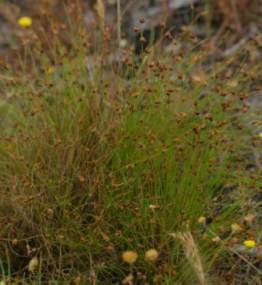
Ficinia is mainly wind pollinated and the fruits are dispersed by wind and water. The gynophore disc is thought to act as an elaiosome (the appendage on the seed that is rich in oil) to attract ants that then drag the seed into their nests underground. The ants eat off the elaiosome and leave the seed in the nest, where it can then germinate safely without being eaten by predators. In the fire-dependant Cape flora this is important as the seed is also protected from the heat of the burn.
Uses
Use
Sedges form an important component of wetlands, where they act as water purifying and erosion control agents. It is the rhizome or stolon that aids this function.
Growing Ficinia
Grow
Apart from Ficinia truncata, Ficinia is not widely cultivated. Nevertheless it may contribute in a garden by aiding with landscaping and also providing attractive foliage around a water feature. Sedges and notably Ficinia are easy to grow and very hardy. Species spread easily and can be divided by being broken apart at the rhizomes or stolons and planted individually (known as division). For this reason they are not commonly sowed from seed. Once split, plants should be placed in a well-drained sandy mix with a good humic content. The soil should be kept damp but it is not essential to keep the plants' feet wet at all times. The variegated leaves of Ficinia truncataprovide interest in any garden setting.
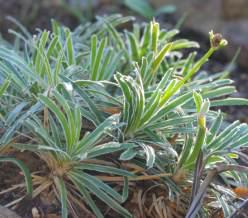
Species

Ficinia gydomontana T.H.Arnold
F. gydomontana is endemic to the Gydoberg Mountains to the east of Ceres and the neighbouring Hottentotskloof. It occurs in mountain fynbos on summits and plateaus, sometimes in rocky areas and also in marshy patches. It is a tussocky perennial growing to 400 mm tall with brownish leaf sheaths; a terminal, dark brown inflorescence and whitish glume margins. Leaf blades and leafy bracts are absent.

Ficinia pygmaea Boeck.
F. pygmaea is a low-growing, hairless, rhizomatous species. The rhizome is covered in pale brown scales. The stems stand solitary; each stem possessing tufted leaves that are chanelled near the base. The flower head has many pale brown spikelets. The species is known from lower mountain slopes in the Clanwilliam District.

Ficinia dunensis Levyns
F. dunensis is endemic to the Western Cape where it is widely distributed, occuring in sand dunes or loose sand. Plants grow up to 200 mm high, possess horizontal stems and have leaves and aerial stems in small tufts. The horizontal stems are covered with dark brown scales when young and with age they become naked and wiry. The leaves are usually half as long as the flowering stems; the leaf sheaths are firm and deep red with the apex squared at the end. Leaf blades are thread-like. One to three spikelets occur in a compact terminal head that is enclosed by two sheathing bracts with wide, dark red-brown bases and leafy tips. The gynophore disc is well developed and lobed. Flowers are produced between August and October.
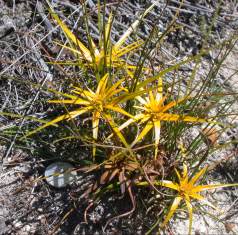
Ficinia radiata (L.f.) Kunth
Ficinia radiata is considered to be one of the most spectacular species of the Cyperaceae and is distinctly 'ficinioid' in appearance. Plants grow together to form a beautiful tufted display, each tuft comprising up to twenty individuals. The flower heads are located at the ends of culms (stems) and reach 150 mm in height. The bracts of the flower head are bright yellow and radiate spirally outwards, resembling a yellow star, hence the common name star grass.
The gynophore disc is large and well developed. The most significant difference between this species and other species of the genus Ficinia lies in the style branch that is markedly reduced so that the style is either unbranched or with three minute notches. The species grows in the southwestern region of the Cape Province where it is distributed from the Ceres Mountains southwards to Cape Town and the Western Cape. It grows on sandy lowlands and lower mountain slopes at altitudes between 200 and 2500 m. Flowering time is from September to December.
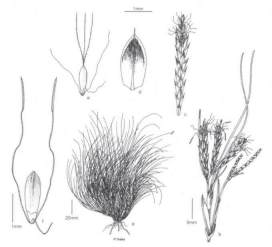
Ficinia esterhuyseniae Muasya
F. esterhuyseniae grows in moist rock crevices in sheltered overhanging rocks in the Western Cape from Swellendam to Clanwilliam at higher altitudes. It is a small, slender plant, growing in tufts with brownish leaf sheaths and leaves that are longer than the culms. The spikelets are cylindrical in shape.
The species is named after Miss Elsie Esterhuysen, a well-known plant collector who collected large amounts of material of Ficinia that is of much use to those attempting to understand the genus. Few other botanists have collected the species, perhaps because of its minute size and specialized habitat. The species is uncommon and if it were not for Elsie Esterhuysen's collections, it would have been poorly collected. Little is known about population size or distribution.

Ficinia micrantha C.B. Clarke
F. micrantha is a rare peninsula endemic, known only from damp peaty places on Table Mountain. Not many collections of this species have been made; the most recent collection is from a population that is now extinct because of a dam construction. The species grows up to about 120 mm high. Leaves are basally located and about half the length of the flowering stems. Leaf sheaths are firm and do not possess ligules. Leaf blades are flat just above the sheath and become cylindrical higher up. There is a single pale spikelet subtended by about six bracts, the lower of which is stiff and leaf-like and appears as a continuation of the stem.

Ficinia quinquangularis Boeck.
This species possesses densely tufted stems with a head of 1-4 chestnut-red spikelets. The upper sheaths are lance-shaped and leafless, whereas some of the lower sheaths bear leaves. It is known from rocky outcrops in mountain fynbos where it occurs from Swellendam east to the Outeniqua Mountains and also further east in the Tsitsikamma Mountains near Humansdorp.
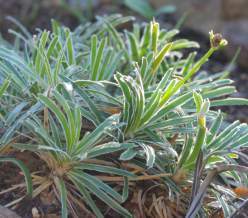
Ficinia truncata Schrad.
A hairless species with rigid horizontal stems covered in a dense array of hard brown scales. Over time the horizontal stems harden to form wiry rhizomes. The stems are 10-30 cm long and fairly rigid. Each stem holds a single rounded flower head. Leaves are flat, thick, parallel-sided and squared-off at the tip. The leaf margins are white and wear away, appearing tattered and membranous. The gynophore disc is rather long and narrow and its margin has three small teeth.
F. truncata occurs in the Riversdale, Mossel Bay and Uitenhage areas.
The species is popular in horticulture.
References
- Arnold, T.H. 1975. A contribution to knowledge of the genus Ficinia Schrad. (Cyperaceae) in South Africa. Bews Botanical Laboratories, Pietermaritzburg.
- Arnold, T.H. 1978. Ficinia radiata. Flowering Plants of Africa 45: t. 1784.
- Arnold, T.H. & Gordon-Gray, K.D. 1978. Notes on the genus Ficinia : F. pygmaea, F. limosa, F. clandestina and nine new taxa from the south-western Cape, South Africa. Bothalia 12: 405-420.
- Arnold, T.H. & Gordon-Gray, K.D. 1982. Notes on the genus Ficinia (Cyperaceae): morphological variation within the section Bracteosae. Bothalia 14: 15-26.
- Clarke, C.B. 1898. Cyperaceae. In W.T. Thiselton-Dyer, Flora capensis 7: 235-260.
- Goetghebeur, P. 1998. Cyperaceae. In K. Kubitzki, The families and genera of vascular plants 4. Springer, Berlin.
- Gordon-Gray, K.D. 1995. Cyperaceae in Natal. Strelitzia 2: 81-89. National Botanical Institute, Pretoria.
- Leistner, O.A. (ed.). 2000. Seeds plants of southern Africa : families and genera. Strelitzia 10. National Botanical Institute, Pretoria.
- Levyns, M.R. 1947. Notes on Ficinia and descriptions of four new species. Journal of South African Botany 13: 65-71.
- Levyns, M.R. 1950. Cyperaceae. In R.S. Adamson & T.M. Salter, Flora of the Cape Peninsula. Juta, Cape Town.
- Muasya, A.M. 2004. Ficinia anysbergensis and F. esterhuyseniae (Cyperaceae), two new species from the Cape Floristic Region of South Africa. South African Journal of Botany 71: 197-200.
- Smith, C.A. 1966. Common names of South African plants. Memoirs of the Botanical Survey of South Africa No. 35.
- Vrijdaghs, A. Goetghebeur, P., Muasya, A.M., Caris, P. & Smets, E 2005. Floral ontogeny in Ficinia and Isolepis (Cyperaceae), with focus on the nature and origin of the gynophore. Annals of Botany 96: 1247-1264.
Credits
Caitlin von Witt
Custodians of Rare and Endangered Wildflowers (CREW)
May 2007
Plant Attributes:
Plant Type: Aquatic, Perennial
SA Distribution:
Soil type:
Flowering season:
PH:
Flower colour:
Aspect:
Gardening skill:
Special Features:
Horticultural zones






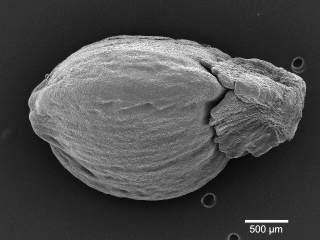
Rate this article
Article well written and informative
Rate this plant
Is this an interesting plant?
Login to add your Comment
Back to topNot registered yet? Click here to register.